By Jamie Botha, DataEQ UK Head of Partnerships UK and the Middle East
Scary stats about the global fashion industry
The Fashion industry has been labelled as one of the most environmentally damaging and socially exploitative industries in the world.
- The industry produces an estimated 10% of all annual global carbon emissions.
- By 2050, Fashion alone could account for26% of the world’s carbon budgetassociated with a 2C pathway.
- Every second the equivalent of one truckload of clothing ends up in a landfill.
The global shift towards sustainability
Consumer attitudes are shifting, with sustainability emerging as a core value driving their purchasing decisions. We’re seeing more and more consumer activism playing out on social media, creating a narrative of ethical accountability for brands and consumers alike.
Consumer attitudes are shifting, with sustainability emerging as a core value driving their purchasing decisions. We’re seeing more and more consumer activism playing out on social media, creating a narrative of ethical accountability for brands and consumers alike.
- Bain & Company revealed that 15% of fashion consumers are actively transitioning their preferences towards sustainable brands, a figure predicted to rise to 50% soon.
- McKinsey found that 60% of consumers would willingly pay more for sustainable products.
- GfK’s research shows that 44% of Millennials in the US take the environment into consideration in their purchase decisions.
- According to McKinsey products making ESG-related claims averaged 28 percent cumulative growth over the past five-year period, versus 20 percent for products that made no such claims.
Many fashion brands are recognising the significance of amplifying their sustainability efforts. However, it’s not just about adopting greener practices, it’s also about effective communication to an increasingly informed and discerning audience. After all, social media acts as the ‘court of public opinion’. The right sustainability messaging can make or break a brand and its initiatives, influencing not just consumers but investors too. Brands need to skillfully navigate these waters or they risk being left on the rack, or worse, going the way of bell bottom jeans.
Our latest report takes a deep dive into the ESG practices of the UK’s leading fashion brands
In collaboration with Relativ Impact, we produced and launched the UK Fashion ESG Index, a first-of-its-kind project aiming to bring transparency to the fashion industry’s ESG practices.
By analysing 1.8 million social media posts from 1 January 2020 to 31 December 2022, we evaluated consumer sentiment towards ESG themes related to nine top UK-based fashion retailers. This novel consumer-driven approach provides valuable insights, shedding light on the key ESG topics that were most significant to consumers during this timeframe.
The conversations gathered from social media offer an honest, unfiltered view of consumer opinion in real-time. This will no doubt prove to be a crucial metric for understanding and improving brands’ strategies.
Social media, if not properly managed, can cause significant damage to brands. Brands can actively participate in discussions about ESG and sustainability to avoid controversy and attract a growing consumer base of individuals who seek sustainable fashion choices.
Real-time monitoring of social media data can also provide:
- Early warning signs of potential ESG crises
- Insights to shape the correct messaging and mitigate further reputational risk
- A way to monitor the impact of your efforts and how they are being received
- The ability to quantify consumer sentiment to understand and cultivate positive relationships with investors and customers
Below, you’ll find a snippet from the index’s Environmental section.
Access the full report here for more detailed insights on this topic, as well as the wealth of information around the Social and Governance sections.
Industry Overiew
Volume of ESG mentons
Over the three-year reporting period, nearly a fifth of all sentiment-bearing UK fashion industry conversation referenced one or more ESG topics.
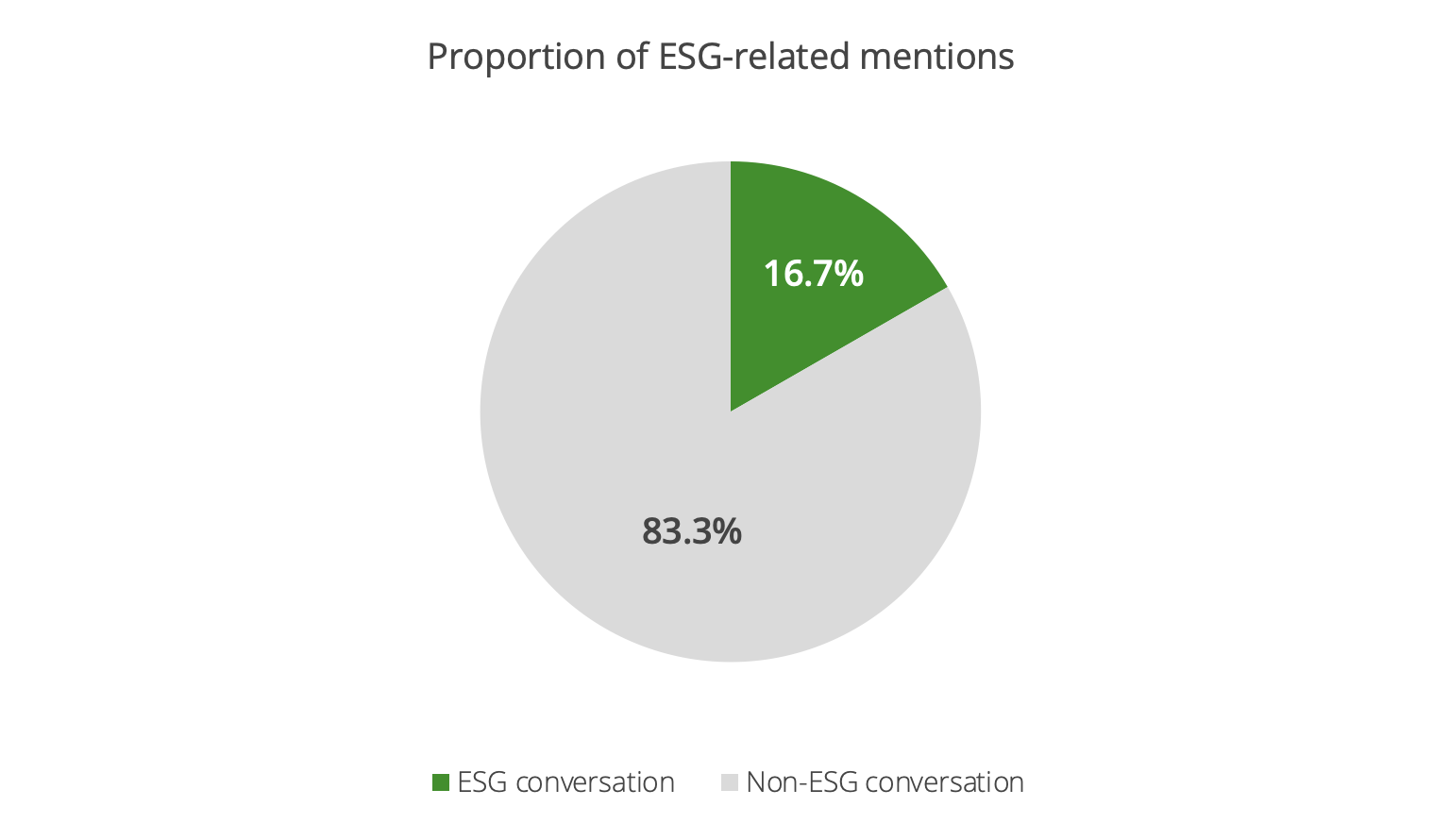
Over the three-year reporting period, nearly a fifth of all sentiment-bearing UK fashion industry conversation referenced one or more ESG topics.
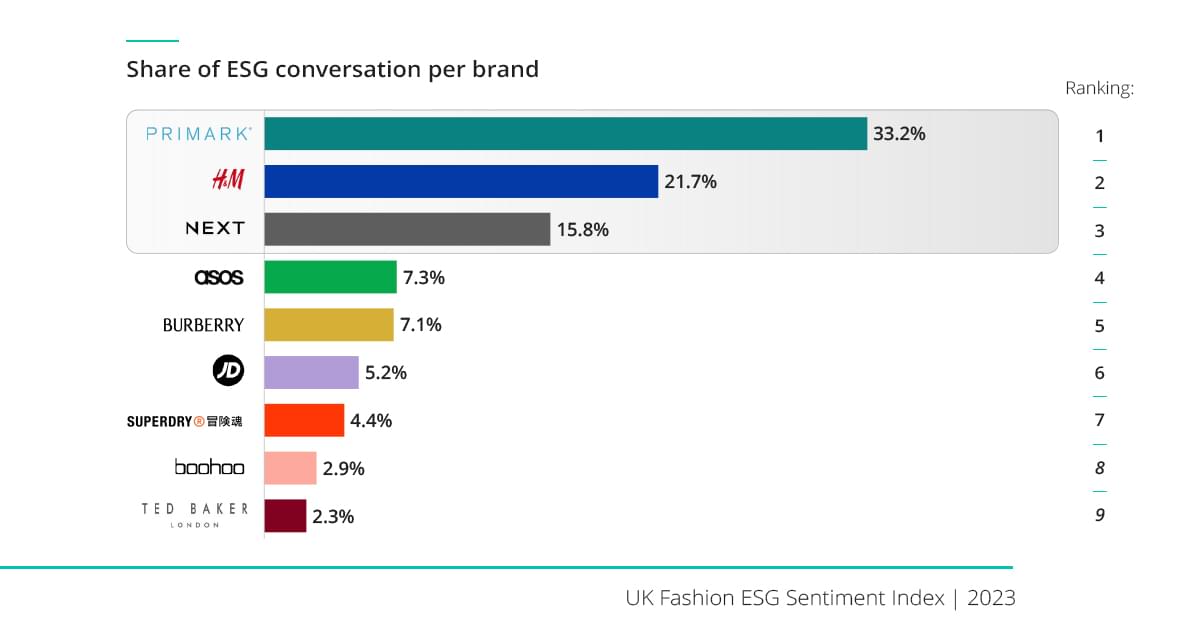
Across the nine brands included in the study, Primark (33.2%) held the largest proportion of this ESG conversation, followed by H&M (21.7%) and Next (15.8%). H&M had the highest proportion of Environmental conversation (51%).
Burberry leads the pack in Net Sentiment, with Primark and Boohoo at the tail-end.
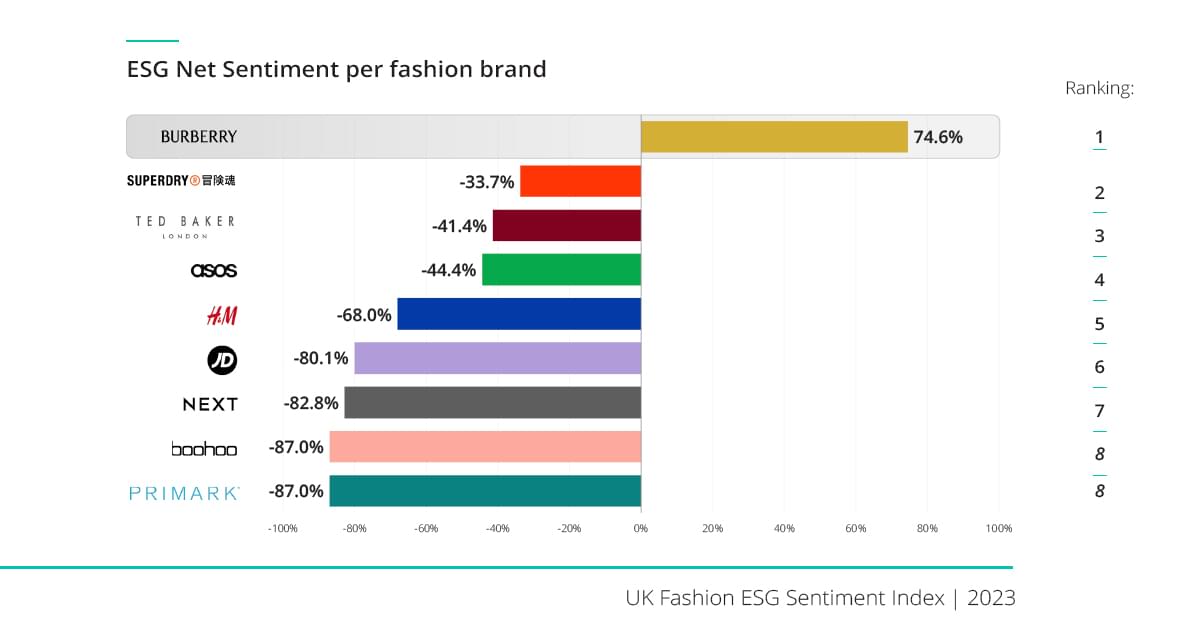
Our analysis revealed that the average ESG Net Sentiment was -63.8%.
Net Sentiment is DataEQ’s aggregated customer satisfaction metric, calculated by subtracting negative sentiment from positive sentiment.
Luxury label Burberry’s score is in stark contrast to the rest of the brands, as the only brand with a positive Net Sentiment of +74.6%. This reflects consumers’ strong appreciation of their ESG related practices.
Environmental considerations were low in volume but high in impact
Despite accounting for only 12.2% of ESG conversations, environmental mentions on social media can have a significant impact on retail brands’ reputation and bottom-line, as seen in several consumer petitions and brand boycotts throughout the reporting period.
Environmental topics of conversation
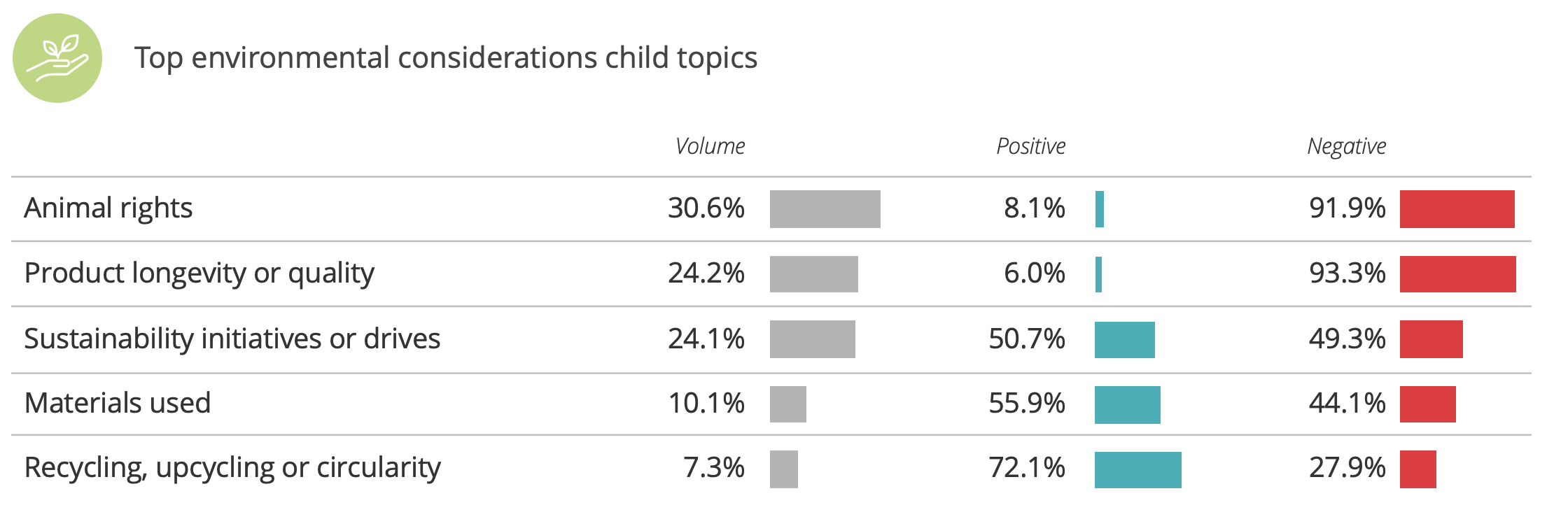
Pulling the thread of unfavourable discussions
Most negative mentions around fashion’s environmental impact centred on material choice, bringing animal rights and product longevity into focus. The vast resources required to create, purchase, use, and dispose of garments contribute significantly to this negative impact.
Next was implicated in a fox-hunting controversy because they stocked Boden clothing - a company associated with the sport.
H&M faced harsh criticism following a PETA investigation revealing apparent animal cruelty by its suppliers, as well as greenwashing allegations after backpedalling on its cashmere and mohair ban.
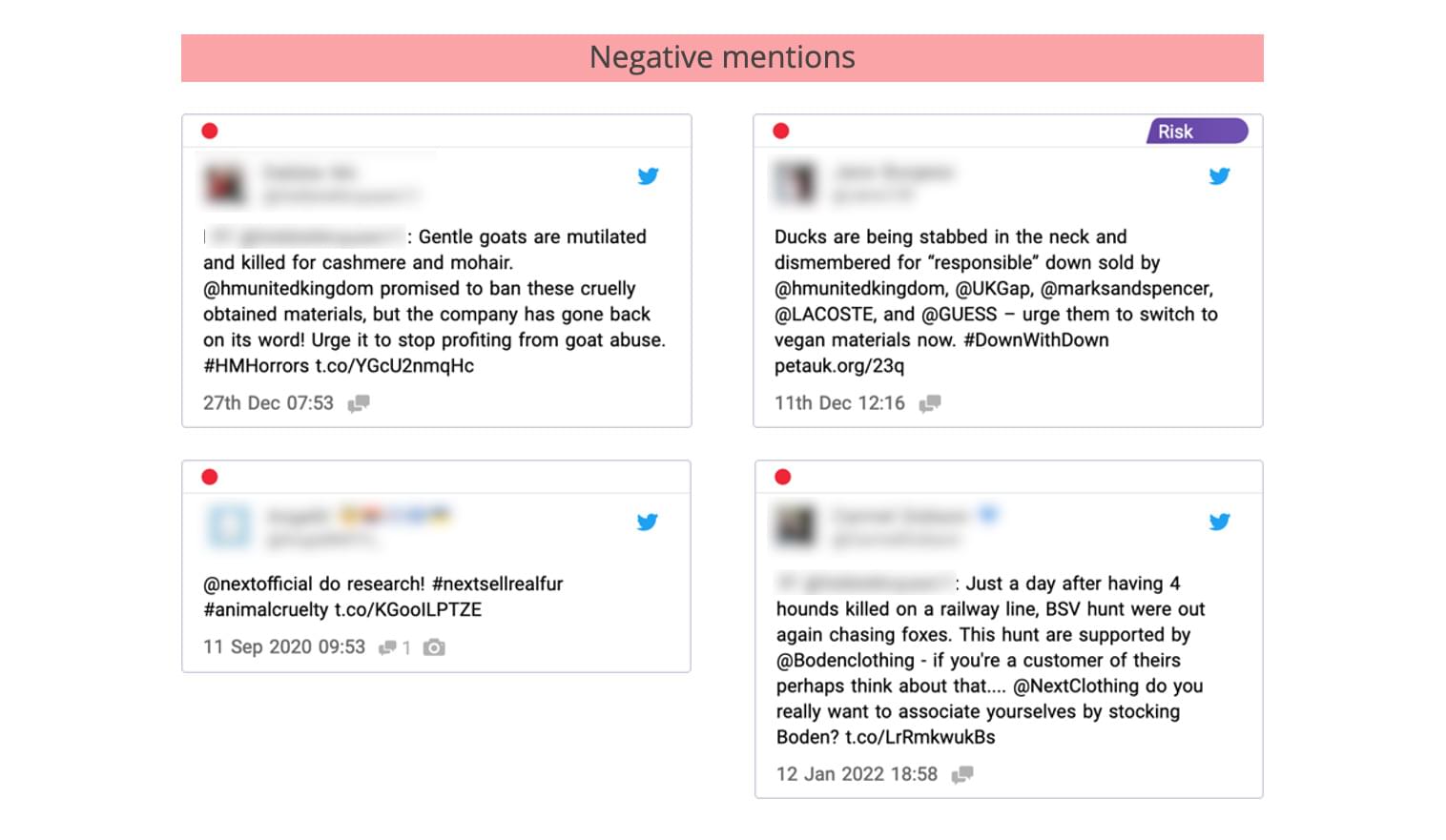
How some brands are sewing positivity online
It’s clear that some brands are moving in the right direction.
ESG pressures are prompting fashion brands to curb their carbon footprints. Consequently, brands are taking various initiatives to minimise their environmental impact during production, sparking positive discussions.
Some brands have introduced “carbon-neutral” lines that diminish carbon emissions, crafted from recycled or sustainable materials like plastic bottles and organic cotton. Notably, Superdry’s commitment to crafting all cotton garments from organic cotton by 2025 was met with public approval.
Burberry also earned consumer accolades for its carbon footprint reduction efforts, alongside initiatives like designing from waste material, donating unused fabric to fashion students, and discontinuing exotic leather usage.

The role of social media in ESG reporting and ongoing monitoring
Widespread media coverage of fashion brands’ negative impact has sparked public discourse and fuelled consumer activism, which increasingly plays out publicly on social media forums.
As consumer and investor demands for sustainable fashion grow, governments are acknowledging this issue’s significance and are actively participating in the dialogue. For instance, New York is currently evaluating Senate Bill S7428A, which would hold fashion brands “accountable to standardised environmental and social due diligence policies”. With overwhelming support on social media, it is likely that similar regulations will be implemented worldwide.
Social media offers valuable insights for sustainability-focused fashion brands, highlighting the importance of monitoring sentiment regarding their ESG initiatives.
This index shows the potential that social media monitoring and analysis has in ESG tracking and reporting. This type of unsolicited, honest feedback offers a unique perspective on the issues that resonate most with consumers – something all brands need to heed.
As this conversation evolves, it will be interesting to see how brands respond and adapt to these consumer expectations.
Implications for investors
ESG and CSR disclosures are becoming focal points for investors as great indicators of a firm’s transparency and accountability.
Combined with consumer-brand relationships and customer sentiment from social media analytics, ESG and CST reporting can greatly shape investment decisions.
According to the SASB, investors are increasingly using sustainability information to “improve their ability to achieve above market returns; reduce risk and volatility and protect against diminished returns and improve environmental and social investment outcomes, with financial returns as an equivalent or a secondary consideration.”
Analysis of over 2,000 empirical studies found no need for corporations to sacrifice financial objectives for sustainability. Therefore, it is in the best interest of investors to incorporate sustainability and ESG practices and metrics in their decision-making processes.
Social media yields vast data insights, providing real-time public sentiment on ESG issues.
When analysed effectively, this data, alongside traditional company-provided information, can aid investors’ performance evaluation, and ultimately where they channel their funds.